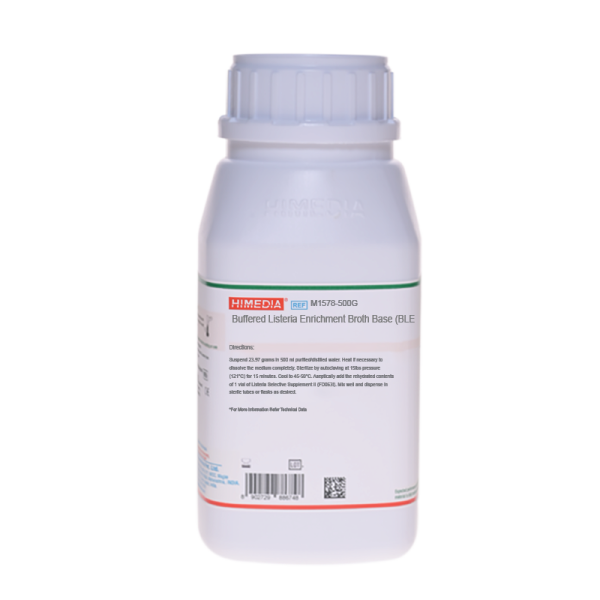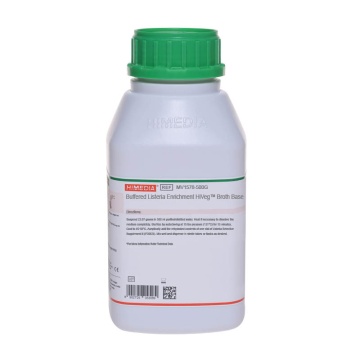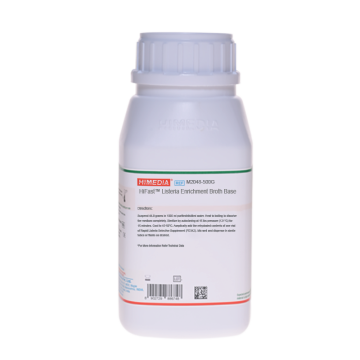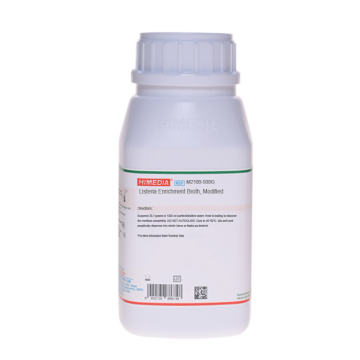 Your enquiry has been submitted
Your enquiry has been submitted
BLE Broth Base (Buffered Listeria Enrichment Broth Base)
Intended Use
Buffered Listeria Enrichment Broth Base is recommended by FDA Committee for enrichment in isolation of Listeria monocytogenes.
Composition
| Ingredients | Gms / Litre |
|---|---|
| Casein enzymic hydrolysate | 17.000 |
| Papaic digest of soyabean meal | 3.000 |
| Sodium chloride | 5.000 |
| Dipotassium hydrogen phosphate | 2.500 |
| Dextrose | 2.500 |
| Yeast extract | 6.000 |
| Monopotassium phosphate, anhydrous | 1.350 |
| Disodium phosphate, anhydrous | 9.600 |
| Sodium pyruvate | 1.000 |
Final pH (at 25°C): 7.3±0.2
**Formula adjusted, standardized to suit performance parameters
Directions
Suspend 23.97 grams in 500 ml distilled water. Heat if necessary to dissolve the medium completely. Sterilize by autoclaving at 15 lbs pressure (121°C) for 15 minutes. Cool to 45°C. Aseptically add the rehydrated contents of 1 vial of Listeria Selective Supplement II (FD063I). Mix well and dispense as desired.
Principle And Interpretation
Listeria monocytogenes is the only species of the Listeria genus that causes Listeriosis in human, however occasionally L. seeligeri, L. welshimeri and L. ivanovii have been related with human diseases. Microbiological and epidemiological evidence from both sporadic and epidemic cases of listeriosis has show that the principal route of transmission is via the consumption of foodstuffs contaminated with L. monocytogenes (2).
L. monocytogenes is a well-documented food borne pathogen because of its high morbidity on infection to animals and humans and also due to its psychrotrophic nature exhibiting high tolerance to heat, cold and desiccation. The organism has been isolated from commercial dairy and other food processing plants, and is ubiquitous in nature, being present in a wide range of unprocessed foods and in soil, sewage, silage and river water (3). Listeria species grow over a pH range of 4.4-9.6, and survive in food products with pH levels outside these parameters (1). Listeria species are microaerophilic, gram-positive, asporogenous, non-encapsulated, non-branching, regular, short, motile rods. Motility is most pronounced at 20°C. Food samples are often contaminated with organisms other than Listeria, which makes its isolation difficult (5). To recover low numbers of L. monocytogenes from food samples, initial enrichment is required. Listeria Enrichment Broth was modified by adding buffering strength thereby making it possible for the medium to be used successfully in conjunction with DNA probe and other methods that are more sensitive than conventional culture procedure. This medium is also recommended by APHA for the selective enrichment of L. monocytogenes.
Casein enzymic hydrolysate and papaic digest of soyabean meal provide amino acids and other complex nitrogenous substances. Dextrose is the energy source. Sodium pyruvate aids in resuscitation of organisms. The phosphates provide buffering capacity. Sodium chloride maintains the osmotic equilibrium. Yeast extract provides vitamin B complex. The medium is rendered selective due to the inclusion of antimicrobial agents. Cycloheximide inhibits the growth of saprophytic fungi. Nalidixic acid inhibits the growth of gram-negative organisms, whereas acriflavin suppresses growth of gram-positive microorganisms.
According to FDAs enrichment procedure (4) for isolation of L. monocytogenes from dairy products, the sample to be tested is inoculated in enrichment broth and incubated at 30°C for 4 hours without the selective supplement. After 4 hours the selective supplement is added and further kept for incubation for additional 44 hours at 30°C. After 24 hours and 48 hours the enriched culture is streaked on Oxford Listeria Medium Base (M1145) and LPM Agar (M1228) / Listeria Identification Agar Base, PALCAM (M1064) and incubated at 35°C for 24-48 hours. Presumptive Listeria colonies are selected and colonies are further purified on Tryptone Soya Yeast Extract Agar (M1214). Purified isolates are then subjected to a variety of biochemical tests to confirm the presence of L. monocytogenes.
Quality Control
Appearance: Cream to yellow homogeneous free flowing powder
Colour and Clarity of prepared medium: Yellow coloured, clear to slightly opalescent solution with slight precipitate
Reaction: Reaction 4.8% w/v aqueous solution at 25°C. pH : 7.3±0.2
pH: 7.10-7.50
Cultural Response: M1578: Cultural characteristics observed with added Listeria Selective Supplement (FD063I) after an incubation at 30°C for 24-48 hours.
| Organism | Inoculum (CFU) | Growth |
|---|---|---|
| Escherichia coli ATCC 25922 | >=10³ | inhibited |
| Listeria innocua ATCC 33090 | 50-100 | good to luxuriant |
| Listeria monocytogenes ATCC 19111 | 50-100 | good to luxuriant |
| Listeria monocytogenes ATCC 19112 | 50-100 | good-luxuriant |
| Listeria monocytogenes ATCC 19118 | 50-100 | good-luxuriant |
| Staphylococcus aureus ATCC 25923 | 50-100 | none-poor |
| Saccharomyces cerevisiae ATCC 9763 | 50-100 | none-poor |
Storage and Shelf Life
Store below 30°C in tightly closed container and the prepared medium at 2 - 8°C. Use before expiry date on the label.
Reference
- Downes F. P. and Ito K., (Ed.), 2001, Compendium of Methods for the Microbiological Examination of Foods, 4th Ed., American Public Health Association, Washington, D.C.
- Bremer and Osborne, 1995, J. Food Prot., 58:604.
- Patel, Hwang, Beuchat, Doyle and Brackett, 1995, J. Food Prot., 58:244
- Hitchens, 1995, FDA Bacteriological Analytical Manual, 8th Ed. AOAC International, Gaithersburg, Md.
- Murray, Webb and Swann, 1926, J. Pathol. Bacteriol., 29:407.
| Product Name | BLE Broth Base (Buffered Listeria Enrichment Broth Base) |
|---|---|
| SKU | M1578 |
| Product Type | Regular |
| Physical Form | Powder |
| Origin | Animal |
| Packaging type | HDPE |
| References | 1. Downes F. P. and Ito K., (Ed.), 2001, Compendium of Methods for the Microbiological Examination of Foods, 4th Ed.,American Public Health Association, Washington, D.C. |
| Customized Product Available | No |












